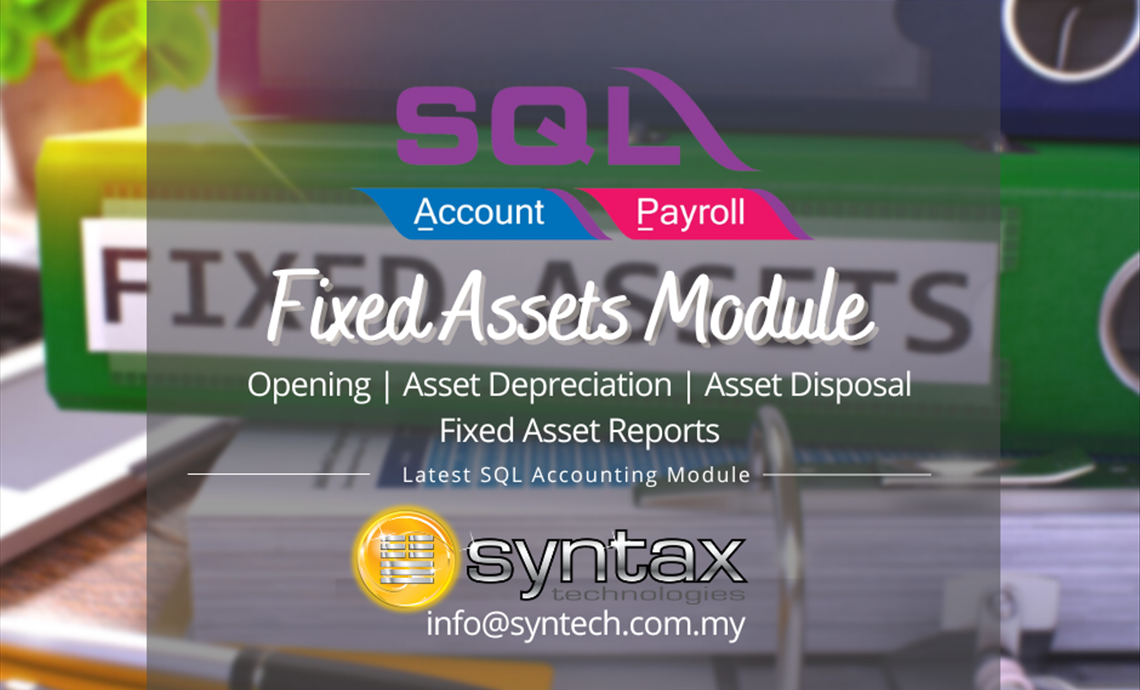固定资产折旧(Assets Depreciation)在会计方面,扮演着非常重要的角色。一般上,公司只能用Excel去处理然后再输入进会计系统,这是一个繁琐而会且计员工很容易犯错。这里有一项对于SQL会计软件用户的好消息,大家一直期待的SQL 固定资产折旧模块 (SQL Fixed Assets Module) 终于推出了。它包含Opening, 折旧计算以及报告。让我们看看它如何运作。
Fixed Assets Depreciation plays an important role in every company accounting process. But companies normally can only use Excel to manage it and re-key back to the accounting system. This is tedious and account staff can easily make mistakes. Good News to all SQL Accounting System users, the long-waited SQL Fixed Assets Module has finally launched. It includes, Fixed Assets Opening, Depreciation Calculation, and Reports. Let’s check out how it works.
This is an additional module for SQL Accounting Software. Please purchase from your SQL Accounting System Dealer. This is also a very “Accounting Intensive” Module.
Please join Facebook Group for SQL Accounting and Payroll related Discussion:
https://www.facebook.com/groups/sqlabc
Please join Facebook Page for Latest SQL Accounting and Payroll Info:
https://www.facebook.com/SyntaxTechnologies/
For complete SQL Accounting System or Payroll System Step By Step Tutorial:
https://www.youtube.com/BryanCheongTV
https://www.syntech.com.my/YouTube/SQL-Accounting-Training
https://www.syntech.com.my/YouTube/SQL-Payroll-Training
First, please make sure you have created different Account Code (Fixed Asset, Accumulate Depreciation, Depreciation, Disposal Gain and Disposal Loss) for different Fixed Asset Group (Example: Motor Vehicle, Office Furniture) in GL-> Maintain Account. Then go to Asset->Maintain Asset Group to create respective Asset Group, select the Depreciation Method and assign all the necessary account code accordingly. If you already have Sub Account for your Fixed Asset Account as individual asset, then you may need to create Stock Group according to individual asset or create another set of Fixed Asset Account without Sub Account and continue with those new account.

Next, we go to Asset -> Maintain Asset Item, to create individual asset. Assign the Asset Group, Acquire Date, Cost, Useful Life (Years), Residual Value, Frequency and click “Generate” to create the Depreciation Table.

For your Routine Asset Depreciation Process, go to Asset -> Process Depreciation. Set the Process Period, Process Date and whether you want to process by individual Asset or by Asset Group, Agent or Area. In the example, it is process by Asset Group, all the Asset in the Asset Group will be processed. If you are comfortable with the result, click the “Save” button, a Journal Entry will automatic generated to record the depreciation by Asset Group.

For Fixed Asset Report, you can view Yearly Depreciation, Asset Analysis and Asset Disposal Listing.
Lets have a look at Asset Analysis, you can select Monthly Quarterly, Half Yearly and Yearly. For Yearly report, it will show 5 years result with historical depreciation, Year-To-Date depreciation, accumulated depreciation and net book value will be displayed for better analysis by Asset Group. If the Asset have been sold, the system will also help you calculate the gain or loss on asset disposal. If you wish to view the result for individual asset, just click the “Asset Item” in “Group/Sort By” section.

To do Asset Disposal, go to Asset -> Asset Disposal. Click “New” set the disposal date, select the Asset, system will display the asset info, including Cost, Accumulated Depreciation, Net Book Value. You just need to key in the Disposal Amount and select the Payment Method, and the disposal gain or loss will be calculated automatically. The GL Journal Entry will also automatic taken-up too.

Let’s go through Asset Depreciation Process again, Asset -> Process Depreciation, but this time we process by Asset Item, the system will break down by each individual asset, the disposal journal will also be taken into account.

For Opening Balance, it is for record of Asset before using SQL. Example you start to use SQL on 1/1/2018, but the asset acquired on 1/1/2017.

You need to insert the Opening at GL -> Maintain Opening Balance, and maintain that Asset as usual.

Process the Depreciation from 1/1/2017 to 31/12/2017 with Process Date set as 31/12/2017. Journal posting is not required for past depreciation process.

*******************************************************************************************************************
Bryan Cheong Advice for Existing SQL Accounting System User that purchase Fixed Asset Module
If you have use SQL Accounting System Journal Entry to do Asset Depreciation for previous years
.
There are 2 options to continue in SQL Fixed Asset Module:
1) Maintain Assets as new assets.
-In maintain Asset
-Key in Net Book Value as Cost, Current Financial Start Period as Date Acquire & in Maintain Asset
-Then continue process depreciation for current year.
*This is straight forward but do not have complete record in SQL.
*Personally Bryan recommend this as it’s a Fresh Start (like new opening) and no need to worry system calculation not match previous posting.
2)Maintain Assets as original purchase info.
-Maintain Asset as original purchase info.
-Do a ‘Process Depreciation” for each Asset with “Date From” set as Purchase Date, and “Date To” + “Process Date” also set as Last Depreciation Journal Date for that Asset.
Example : Purchase on 01/01/2016. Last Depreciation Journal Date for that Asset is 31/12/2021.
When Process Depreciation set
From 01/01/2016 to 31/12/2021.
Process Date : 31/12/2021
After process, go to Journal, and tick “Cancel” for this Journal. This will prevent posting to account but will still capture in Asset Depreciation Table in Maintain Asset as record.
-Then continue to do current year depreciation as normal.
* This will generate a complete depreciation table in Maintain Asset for individual asset, user may edit the depreciation value if it is different with your previous journal.But more work to do.
*******************************************************************************************************************
You can also check the report to see the Opening Balance matches the Asset Cost and depreciation for the past year.

Please refer follow for the Tutorial Video:

